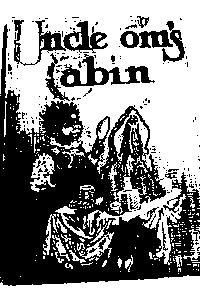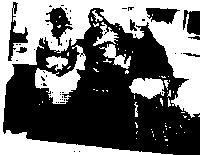The images displayed in the current Hawthorne-Longfellow Library show, “Visualizing Uncle Tom,” are so disturbing that a university in Great Britain decided against presenting them to the public.
After his employer, the University of Birmingham declined to support his exhibit, Professor of American Studies Richard J. Ellis sought another audience. He received invitations from several American colleges and universities, including Bowdoin, to display his sizable collection of 19th- and 20th-century images and objects related to Harriet Beecher Stowe’s 1852 novel, Uncle Tom’s Cabin.
In addition to Ellis’ personal collection, the Bowdoin library has contributed some archival material from its Stowe Collection to the exhibition, which will be up through May 31.
Stowe wrote Uncle Tom’s Cabin here in Brunswick, wanting to add her voice to the anti-slavery movement. The novel quickly became one of the most well-read books in the country, outsold only by the Bible, and it played a critical role in hardening people’s attitudes against slavery. Over several decades, publishers printed many new editions of Uncle Tom’s Cabin, with thousands of different illustrations. The story also inspired adaptations, plays and memorabilia, including posters, kerchiefs and children’s plates. It is in these myriad illustrations and objects that Ellis finds particular cultural and historical significance.

Richard Ellis talks to students at the “Visualizing Uncle Tom” exhibit in the Hawthorne-Longfellow Library
While Ellis acknowledges that modern readers of Uncle Tom’s Cabin will blanche at the blatant racism in the novel, he argues that images generated in response to Stowe’s book often misrepresented her characters. “Visualizing Uncle Tom” demonstrates how frequently illustrators drew Stowe’s African American characters to appear passive, supplicating and anodyne, rather than angry, active and empowered. In some pages, children and women are sexualized, sometimes in violent ways. Particularly in 20th-century depictions, characters look, according to Ellis, like “some ghastly minstrel caricature.” Ellis called these visual interpretations “amplified, distorted and exaggerated. …We get this movement away from the text, so the novel recedes behind the publicity.”
Recently, students in the course, The After-Lives of Uncle Tom, taught by Bowdoin English professors Tess Chakkalakal and Peter Coviello, gathered at the H-L library for a guided tour. Ellis told them, “We can see there’s this huge penumbra around Uncle Tom’s Cabin and its characters that changes our understanding of the novel and what it’s about. It’s one of the reasons Uncle Tom’s Cabin is situated in culture where it is.”
Seeing how closely Ellis’ collection reflected the themes in her and Coviello’s course, which examines the longterm effects of Uncle Tom’s Cabin in literary and print culture, politics, law and other realms, Chakkalakal invited Ellis to come to Bowdoin in January as a guest scholar. His visit was funded in part with a special Andrew W. Mellon Foundation grant, which is supporting a Bowdoin initiative to enhance interdisciplinary studies across the humanities in certain areas, including the Civil War.
Chakkalakal says despite the flaws of Uncle Tom’s Cabin, she teaches Stowe’s influential book because the novel “helps explain ourselves to ourselves. …If you don’t know Uncle Tom’s Cabin and its lexicon, you’re illiterate in American culture. It’s a form of illiteracy because [Uncle Tom’s Cabin] teaches us about race, slavery and stereotypes.”
Click on the photos to read captions by Richard J. Ellis












